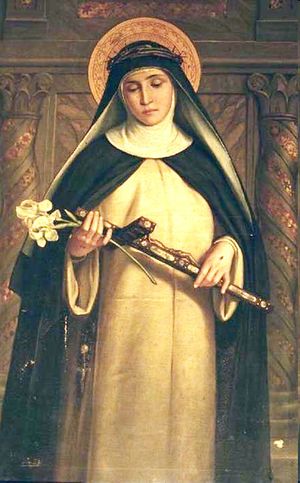Catherine of Siena

(b. March 25, 1347) Italian mystic, defender of the pope and the Church. A previous embodiment of Elizabeth Clare Prophet.
At age six in a powerful religious experience Catherine saw the radiant figure of Christ the King raise his hand and bless her. He was seated on a throne, crowned with a mitre and surrounded by the apostles Peter, Paul and John. Believing that her vocation was to be in the world but not of the world, at age sixteen she became a Sister of Penance, a member of the Dominican third order who wears a habit but is not confined to a convent.
For the next three years Catherine remained cloistered in a small room in her father’s house, living a life of austerity, solitude and silence, withdrawing into the “inner cell” of the knowledge of God and self, as she described her communion with the Lord. She had many visions and conversations with Jesus, culminating in the spiritual marriage with Christ. During that time Catherine received Jesus’ teaching “I, nothing; God, All. I, nonbeing; God, Being.” This fundamental truth inspired in her the humility and the conviction that enabled her to confront the forces threatening the Church and society in the turbulent fourteenth century.
At Jesus’ direction Catherine returned to public life in Siena, where she tended the poor and the sick. As her reputation for spirituality became known, there gathered around her a circle of devotees from all walks of life who called her their “sweet holy mother.” Catherine acted as a peacemaker and diplomat in order to bring peace to Italy and reform the Church. She traveled widely and addressed hundreds of letters to the prelates and sovereigns of the day, giving counsel and advice yet directly confronting misdeeds. Wherever Catherine went, preaching, teaching and healing, she brought a spiritual revival and led thousands of souls back to the Church. In 1375 on a visit to Pisa, Catherine received the stigmata, which at her request remained invisible until after her death.
In her absolute devotion to the papacy Catherine, accompanied by twenty-three devotees (friars, nuns and laymen), traveled to Avignon, France, where the popes had resided for the previous seventy years, in order to convince Pope Gregory to return the papacy to Rome. In 1377 the pope returned to Italy, but a year later with the election of his successor, Urban VI, certain cardinals set up a rival, or “anti-pope,” Clement VII. Thus began the “Great Schism,” which absorbed the remainder of Catherine’s life as she attempted to gain for Pope Urban VI the recognition that was rightfully his.
In November 1378 she moved to Rome to devote herself to the cause of the papacy. During the last months of her life Catherine went daily to Saint Peter’s basilica where she spent hours in prayer before the mosaic of “la Navicella,” the ship of the Church. Just before Lent in 1380 she had a vision of the ship being lifted out of the mosaic and placed upon her shoulders. Three months later, on April 29, 1380, at age 33, Catherine died, exhausted by her penances and efforts in the service of the pope and the Church. “O eternal God,” she had prayed upon her deathbed, “receive the sacrifice of my life for the sake of this mystical body of holy Church.”
Her greatest work, the “Dialogue,” a spiritual treatise in the form of conversations with God the Father, was dictated by Catherine to her secretaries during a five-day state of ecstasy. About four hundred of her letters have survived as well as twenty-six of her prayers.
Catherine was canonized in 1461; she was declared the patron saint of Italy in 1939 and proclaimed a Doctor of the Church in 1970. Her feast day is celebrated April 30.
Sources
Pearls of Wisdom, vol. 31, no. 46.
